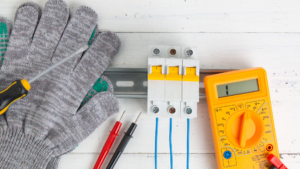 Circuit breakers are safety devices, designed to protect your household from fires, shocks, and damage by cutting power to overloaded circuits. A tripped circuit is an inconvenience, but it can be easily resolved. However, when a circuit breaker keeps tripping, there’s normally a larger, underlying problem you need to address.
Circuit breakers are safety devices, designed to protect your household from fires, shocks, and damage by cutting power to overloaded circuits. A tripped circuit is an inconvenience, but it can be easily resolved. However, when a circuit breaker keeps tripping, there’s normally a larger, underlying problem you need to address.
Overcurrent
The primary reason breakers keep tripping is because they’re drawing more electricity than they were designed to handle. Overloaded circuits are a serious fire risk. They can also melt your internal wiring, which can be expensive and frustrating to repair.
Before resetting a tripped circuit, disconnect all the appliances connected to it. After restoring power, plug them back in one by one, starting with the biggest and working your way down. The one that trips the circuit should be moved to another part of the house. If that’s not possible, consider installing a new, dedicated circuit and outlet for the largest device in the room.
Short Circuit
Electricity is supposed to flow along carefully controlled pathways. When it flows along a wrong or unintended pathway, it’s known as a short circuit. Because the same voltage is being applied to a connection with little electrical resistance, current flows extremely rapidly through a short circuit. The resulting power surge can cause a fire or significant structural damage. In extreme cases, it can even trigger an explosion. Most shorts are the result of bad or degraded wiring. There are three wires inside every circuit:
- Hot wire. Carries electricity from the breaker panel to the outlet
- Neutral wire. Carries used electrons back to the power source
- Ground wire. Directs excess current safely into the ground
Normally, these wires are kept carefully separated. However, faulty installation or loose connections sometimes allow them to come into contact with each other and create a short. Rodents are another problem. They’ve been known to chew on wire casings and expose the copper filaments underneath, making it possible for electricity to jump between cables.
Short circuits sometimes let out a distinct “POP!” when you activate a device connected to them. They might also give off sparks or start to smoke. While shorts are more common in outlets, they can occur within appliances as well. If you suspect an appliance may have a short, test it out in several rooms. If it causes your circuit breaker to keep tripping, then the appliance will have to be replaced.
Ground Fault
Before the introduction of ground wires, touching a malfunctioning outlet often resulted in an electrical shock. Electricity is made of negatively charged particles, while the Earth is full of positively charged particles. As a result, if given the chance, electricity always flows along the shortest route to the ground. Electricity had nowhere to go in older outlets, so when it surged, it would flow through anyone unlucky enough to come into contact with them. Ground wires provide an escape route for excess current. A ground fault occurs when electricity flows unexpectedly into the ground, normally due to:
- Moisture. Water is an excellent conductor of electricity. Dripping pipes and leaky seals allow moisture to seep into electrical outlets and redirect electrical current.
- Damage. Frayed casings, exposed filaments, and bad connections allow hot wires to come into contact with ground wires.
- Dust and Debris. Though dust doesn’t conduct electricity, it does attract moisture. A thick layer of dust, even stray objects, can lead to unwanted and unexpected power surges.
- Deterioration. Like every part of your house, your internal wiring degrades over time. Old wires often struggle with the amperage required by modern appliances, increasing the likelihood of an overload.
If you suspect your outlet has developed a short circuit or ground fault, you can check the wires by unscrewing the faceplate and examining the terminal. Keep in mind that live wires are extremely dangerous, so always deactivate the breaker switch before handling them. If you find damage, don’t try and fix it yourself. No matter how simple the job seems, tinkering with your internal wiring will likely cause further problems down the line. Leave it to a professional instead.
Protect Your Electrical System
Agway powers and protects your electrical system. Our EnergyGuardTM Program covers your furnace, boiler, air conditioning, and internal wiring* against damage caused by wear and tear. Fixing or replacing vital components can cost hundreds of dollars and upset your household budget, but EnergyGuardTM helps shoulder the burden.
When the need for repair occurs, our customers contact us instead of wasting time hunting for a qualified technician. Our support team sends a local contractor to your door as quickly as possible. We pay for corrective maintenance and all covered parts. There are no service fees or deductibles. Everything is included in your supply cost. Sign up today to save on repairs!
*Coverage depends on commodity purchased.